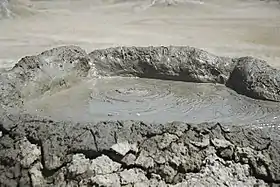Mud volcanoes in Azerbaijan
Azerbaijan has the most mud volcanoes of any country, spread broadly across the country. 350 of the 700 volcanoes of the world are in the Azerbaijani Republic.[1] Local people call them “yanardagh” (burning mountain), “pilpila” (terrace), “gaynacha” (boiling water) and “bozdag” (grey mountain) alongside its geographical name – mud volcanoes.


Submarine mud volcanoes
Underground and submarine mud volcanoes are also famed in Azerbaijan. There are more than 140 submarine volcanoes in the Caspian Sea. Eight islands in the Baku Archipelago are mud volcanoes by origination. The other kind of mud volcanoes are wells. Their activity can be observed among strata of various ages. According to the information, mud volcanoes initially began their activity in the territory of Azerbaijan 25 million years ago.
Eruption of mud volcanoes

About 200 eruptions have occurred in 50 volcanoes in the territory of Azerbaijani Republic since 1810. Eruption of mud volcanoes is accompanied by strong explosions and underground rumbling. Gasses come out from the deepest layers of the earth and immediately ignite. A height of a flame over volcano reaches 1000 meters (Garasu volcano). Toragay volcano erupted 6 times from 1841 to 1950.
Mud volcanoes are associated with oilfields. Rich oil and gas fields are found in the territories of mud volcanoes (Lokbatan, Garadgh, Neft Dashlari, Mishovdagh and others). In addition, lava, mud and liquid erupted by mud volcanoes are used as raw materials in chemical and construction industries and also in pharmacology.
Interesting facts
- Geologists of NASA studying Mars planet, concluded that mud volcanoes of Azerbaijan are similar to uplands of the planet for their structure.
- The eruptions of volcanoes are used as raw material in the chemical and construction industries as well as in pharmacology.
- Volcanic clay and mud are used in the treatment of diseases related nervous system, skin and rheumatism.
- On September 5, 2004 the largest mud volcano in the territory of Azerbaijan was added into the Guinness World Records.[2]
- Otman Bozdag is the second largest mud volcano, according to the local media reports. Its eruption on September 23, 2018 produced mud extrusions that has reached 4 km long and cracks as deep as 80 m.[3][4]
Protection of mud volcanoes
In 2007, the State Natural reserves were created by the decree of the President. Natural reserve covers Baku and Absheron peninsula. Illegal actions there which include construction works, pollution, and destruction are prohibited. Main volcanoes according to ANAS are located near Caspian Sea coast and reach up to 400.0 m (1,312.3 ft). 52 volcanoes got under state protection.[5]
Origins of mud volcanoes
Mud volcanoes appeared on the territory of the present Azerbaijan Republic 25 million years ago. Near mud volcanoes, deposits of oil and gas can be found. Mud volcano's components can be used as raw materials for the chemical and construction industries, as well as for pharmacology.
Eruption of volcanoes
There are several noticeable eruptions in past years:
GoturDag
This volcano is located 70 km away from the capital. Height of the volcano is 150 m (492 ft) and depth reaches to 20 m (66 ft). Last eruptions occurred in 1966 and in 1970. The overall volume of breccia is about 530×106 m3 (19×109 cu ft).
Bahar
Bahar is located 55 km away from Baku. Height reaches 45.0 m (147.6 ft). The last eruption was detected in 1993.
Lokbatan
Lokbatan is located 15.0 km (9.3 mi) away from the capital. 17 eruptions from the 19th century were detected. The last eruption was in 2001.[6][7]
Ayranteken
This volcano can be considered as the most active volcanoes in Azerbaijan. The volcano is located 65 km away from the capital. Many eruptions are accompanied by underground explosions and huge flames. Height of the volcano reaches 190 meters. First eruptions are dated 1964 up to 1990.[7] Near the volcano, 800m length cracks can be found. Breccia of this volcano covers 805 hectares.
Otman Bozdag
This volcano erupted in September 2018. 40 meters deep, cracks were the result of the recent eruption.[8]
Moose
The last eruption of moose occurred in 1970. Flames reached up to 1 km in height. Local earthquakes were located.[9]
References
- "Mud Volcanoes of Azerbaijan". Atlas Obscura. Retrieved 2020-02-10.
- "Largest mud volcano". Guinness World Records. 2004-09-15. Retrieved 2018-09-24.
- "Vulkan püskürən ərazidə çatların dərinliyi 80 metrə çatdı". Oxu.az. 2018-09-23. Retrieved 2018-09-24.
- "Vulkan püskürən ərazidə çatların dərinliyi 80 metrə çatıb". Bizimyol. 2018-09-23. Retrieved 2018-09-24.
- "Грязевые вулканы Азербайджана претендуют на "Семь чудес света"". Trend.Az (in Russian). 2009-07-23. Retrieved 2019-07-19.
- "Azeri mud volcano flares". 2001-10-29. Retrieved 2019-07-19.
- "ГРЯЗЕВОЙ ВУЛКАНИЗМ И ЗЕМЛЕТРЯСЕНИЯ" (PDF).
- "В Баку произошло извержение вулкана (ВИДЕО)". Trend.Az (in Russian). 2018-09-23. Retrieved 2019-07-19.
- "Извержения грязевых вулканов". CollectedPapers (in Russian). 2015-06-15. Retrieved 2019-07-19.
External links
- Грязевые вулканы Азербайджана — одно из 7 новых чудес природы
- О природе грязевых вулканов. Профессор В. Н. Холодов. Геологический институт РАН, Москва
- Координационный Совет Азербайджанской Молодежи